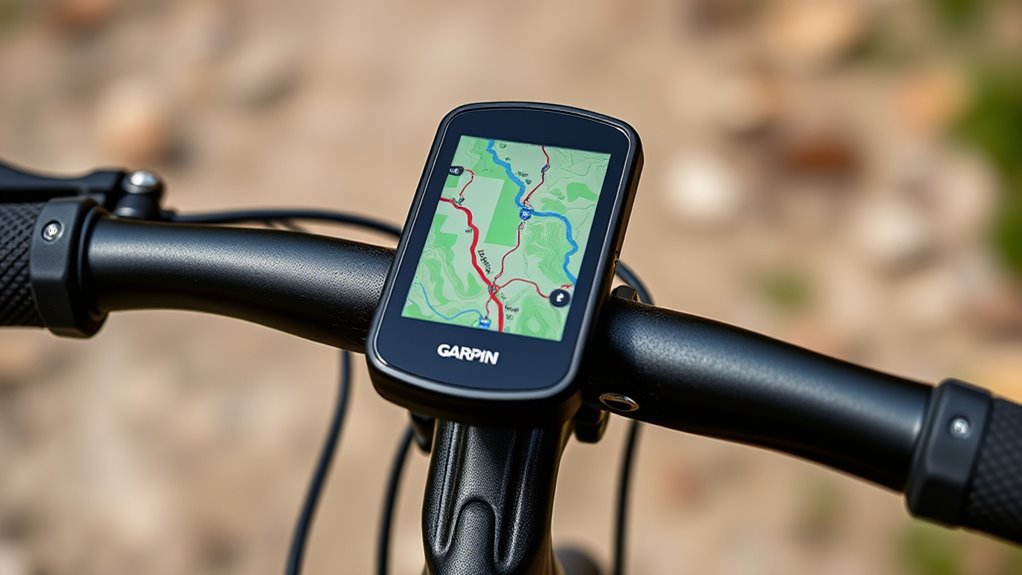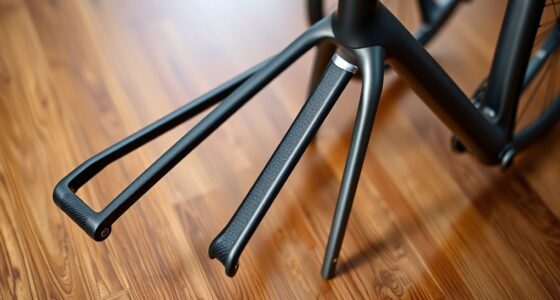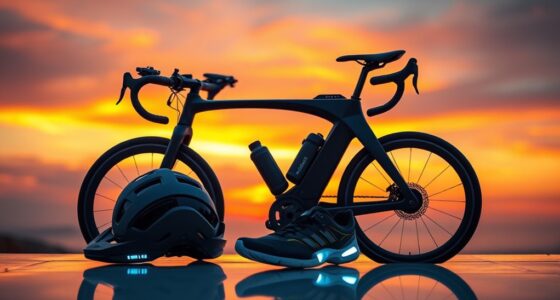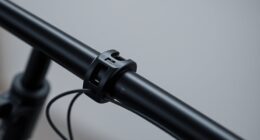When choosing a cycling GPS device, focus on accurate navigation with detailed maps and real-time updates, so you stay on course no matter the terrain. Look for long battery life, water resistance, and durable builds to handle outdoor conditions. Metrics like heart rate, elevation, and gradient help track your performance and improve over time. An intuitive interface and seamless connectivity ensure quick access and data sharing. Keep exploring to discover even more features that can elevate your ride.
Key Takeaways
- Accurate GPS and real-time updates for reliable navigation and route tracking.
- Long-lasting, water-resistant batteries with durable, rugged design for outdoor conditions.
- Comprehensive cycling metrics like heart rate, elevation, and gradient for performance analysis.
- User-friendly interface with seamless connectivity to sensors and cycling apps.
- Compact, lightweight build with easy installation and controls for convenience during rides.
Navigation Accuracy and Mapping Capabilities

When choosing a GPS device for cycling, navigation accuracy and mapping capabilities are crucial factors to take into account. You need reliable route planning features that help you find the best paths, whether you’re exploring new trails or sticking to familiar routes.
Precise positioning ensures you stay on course, especially in remote areas with weak signals. Look for devices that offer detailed maps and real-time updates, so you can easily follow your intended route. Accurate GPS signals are essential for maintaining reliable positioning in challenging environments. In addition, devices that incorporate AI-driven solutions may provide enhanced route suggestions and adaptive guidance based on real-time conditions. Incorporating contrast ratio considerations in the display can also help improve visibility in various lighting conditions, making it easier to read maps and directions on the go.
Turn by turn navigation is essential, guiding you clearly through complex intersections and turns without guesswork. A device with accurate navigation minimizes detours and keeps your ride smooth, safe, and efficient.
Prioritizing these features guarantees a seamless cycling experience, no matter where your adventure takes you. Ensuring your device has real-time updates can significantly enhance navigation reliability, especially in areas with changing terrain or signal disruptions.
Battery Life and Power Management
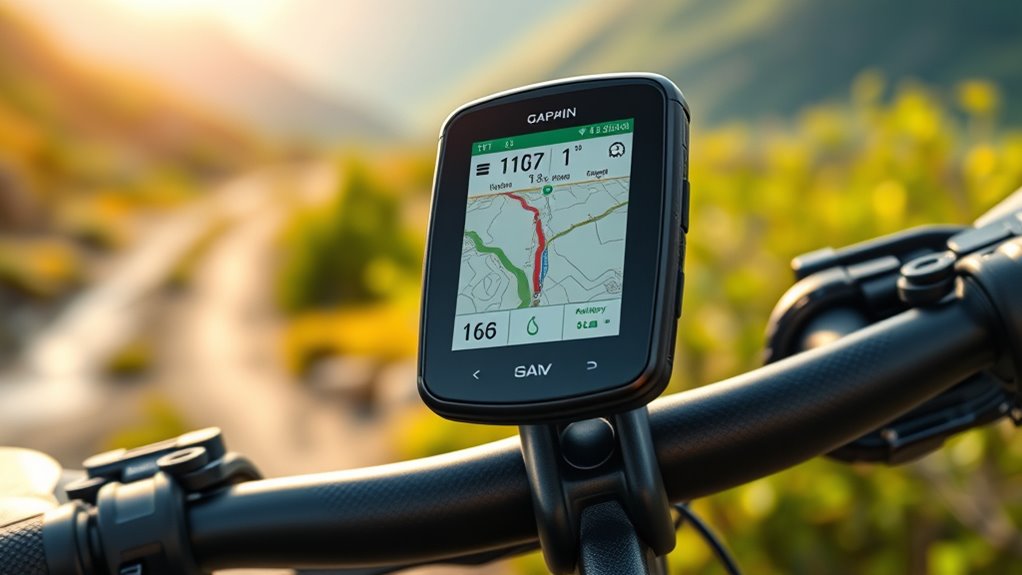
Battery life and power management are essential considerations because a device that runs out of juice mid-ride can disrupt your entire journey. Look for GPS units with long-lasting batteries that can handle extended rides without frequent recharging. Some devices offer solar charging features, which can help top up your battery during daylight, extending your ride time. Additionally, devices with replaceable batteries give you the flexibility to swap out power sources when needed, ensuring continuous use without waiting for a recharge. Consider how the device manages power; features like power-saving modes or automatic shut-offs can conserve energy when you’re not actively using the GPS. Prioritizing these aspects ensures your device stays operational, so you stay focused on your ride. Battery performance is a critical factor that can influence overall device reliability during long cycling trips. Incorporating power management strategies can significantly extend your device’s usability and minimize interruptions during your ride. To optimize your experience, also evaluate how well the device maintains data integrity during extended use, especially in remote areas where connectivity might be limited. Proper device maintenance can further enhance battery longevity and overall performance, ensuring your GPS remains dependable in all conditions. Additionally, selecting a device with a robust power source can help prevent unexpected failures in critical moments.
Cycling-Specific Metrics and Data Tracking

Many cycling GPS devices include heart rate monitoring, helping you track your effort and fitness levels in real time. Elevation and gradient data give you insights into the terrain, so you can plan your climbs and descents more effectively. These metrics provide valuable feedback to improve your training and performance on every ride. Additionally, some devices feature celebrity lifestyle insights, offering inspiration and tips for maintaining a balanced and motivating fitness routine. The high pressure capabilities of advanced GPS units also enable more precise data collection for tracking your progress over time, which can be enhanced by understanding yarn yardage for related sports or hobbies. Incorporating Volkswagen Tuning principles can inspire innovative ways to optimize your training gear and enhance your cycling experience.
Heart Rate Monitoring Capabilities
Heart rate monitoring is a crucial feature that allows cyclists to gauge their effort and optimize training. By tracking your heart rate in real-time, you can stay within specific heart rate zones, ensuring effective workouts and avoiding overexertion. This capability enhances your fitness tracking, giving you deeper insights into your progress and recovery. With accurate heart rate data, you can push harder or ease up when needed, making every ride purposeful. Imagine feeling confident that your effort aligns with your goals, whether improving endurance or building strength. The understanding of flushing mechanisms can help you better interpret your body’s responses and prevent unnecessary strain during intense rides. Additionally, precise monitoring of heart rate zones can improve your overall training effectiveness. Recognizing the importance of ECU tuning in optimizing engine performance can inspire similar customization in your training regimen to maximize results. Moreover, many cycling GPS devices now include features like data tracking that allow for detailed analysis over time, helping you fine-tune your training plan for optimal performance. Tracking your resting heart rate can also provide early indicators of overtraining or fatigue, ensuring you stay healthy and consistent. Here’s what heart rate data can evoke:
| Zone | Intensity Level | Benefits |
|---|---|---|
| Zone 1 | Light | Recovery, base fitness |
| Zone 2 | Moderate | Fat burning, endurance building |
| Zone 3 | High | Performance, anaerobic capacity |
Elevation and Gradient Data
Elevation and gradient data add a vital layer to your cycling metrics, providing insights into the terrain you ride. Tracking altitude gain and route elevation helps you understand how challenging your ride is and plan better for future routes. Speaks 4 Me Online emphasizes the importance of engaging narration, which is crucial when reviewing detailed data visually and audibly. This data allows you to monitor how much effort you’re putting into climbs and descents, making training more effective. Accurate elevation data is essential for reliable information, ensuring your training and navigation are based on trustworthy data. With accurate elevation and gradient info, you can identify steep sections and optimize your pacing. Many GPS devices offer real-time updates on elevation changes, helping you stay aware of upcoming climbs. Here are some key features to look for:
- Precise altitude gain measurements
- Route elevation profiling
- Gradient percentage display
- Climb and descent analytics
- The integration of cycling-specific metrics enhances your ability to analyze performance and tailor your training sessions effectively. Additionally, many devices incorporate privacy and data security features to protect your location data during tracking.
User Interface and Ease of Use

A user-friendly interface is crucial for maximizing the benefits of a cycling GPS device. You want touchscreen responsiveness that’s quick and accurate, so you don’t waste time struggling with inputs. Smooth touchscreen reactions make it easy to select routes, view data, and switch screens on the fly.
Good menu navigation is equally important; intuitive menus let you find what you need without confusion or frustration. Look for a device with clear icons and well-organized options, so you can operate it confidently while riding.
A simple interface reduces distraction and ensures you stay focused on your ride. Ultimately, a straightforward user interface makes your cycling experience more enjoyable and efficient, allowing you to access essential information effortlessly. Additionally, choosing a device with easy-to-understand menus can help prevent potential safety issues caused by complex navigation.
Connectivity and Compatibility Features
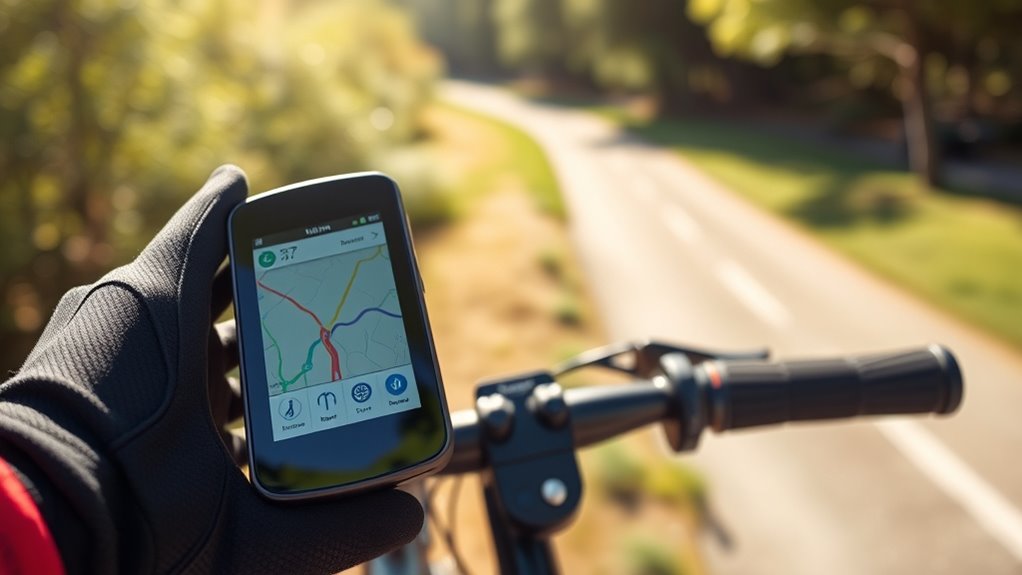
Connectivity and compatibility features are essential for getting the most out of your cycling GPS device. They guarantee seamless data transfer and synchronization with other devices, making your rides more efficient.
Look for wireless syncing options, which allow you to update routes, upload stats, and share progress effortlessly.
Device pairing capabilities enable you to connect your GPS with sensors like heart rate monitors or cadence sensors for accurate tracking.
Compatibility with popular apps and platforms, such as Strava or Garmin Connect, helps you analyze your performance and plan routes easily.
Additionally, check if your device supports Bluetooth or ANT+ connections for versatile pairing options.
These features simplify your cycling experience and keep your data organized across all your devices.
Durability and Design for Outdoor Use
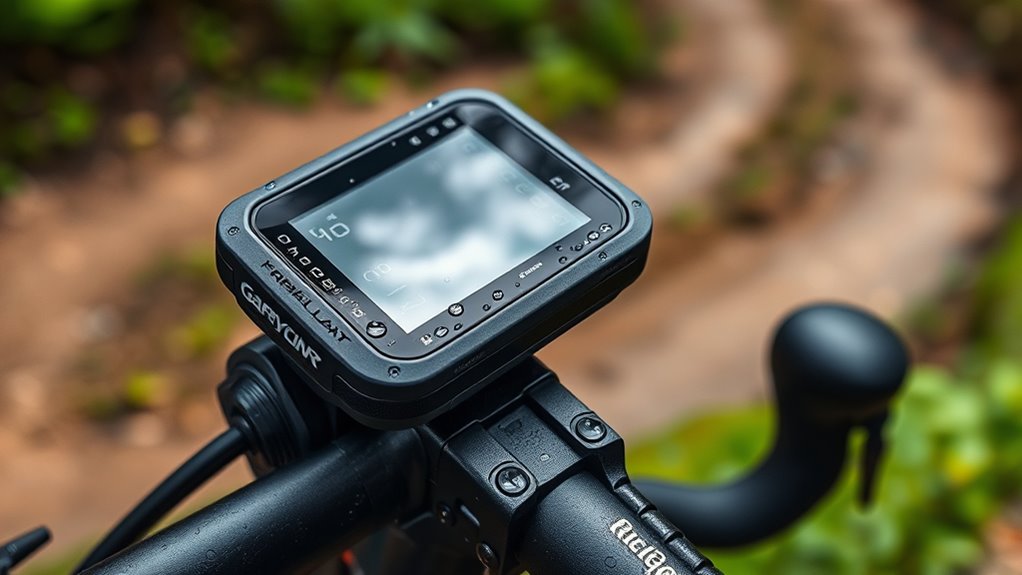
When choosing a GPS device for outdoor cycling, you need one that can handle tough conditions. Consider water resistance levels, rugged construction materials, and a compact, lightweight design to guarantee it survives your rides.
These features help you stay focused on your route without worrying about damage or bulk.
Water Resistance Levels
Water resistance is a crucial factor to take into account when choosing a GPS device for cycling, especially since rides often take you through rain, mud, and puddles. Understanding waterproof ratings helps you gauge how well your device can withstand water exposure during outdoor adventures.
Look for devices with clear IP ratings, such as IPX7 or IPX8, indicating protection against water immersion. These ratings ensure your GPS can handle unexpected splashes or rain without damage.
Keep in mind that water resistance isn’t permanent; seals can degrade over time. To avoid surprises, consider models with higher waterproof ratings for extended water exposure.
- IPX7: suitable for splashes and rain
- IPX8: can handle continuous water immersion
- Sealed ports to prevent water ingress
- Regular maintenance extends durability
Rugged Construction Materials
Choosing a GPS device with rugged construction materials guarantees it can withstand the tough conditions of outdoor cycling. Durable materials like reinforced plastics or metal alloys provide excellent shock absorption, protecting your device from accidental drops and rough terrain.
This resilience assures your GPS stays functional throughout rugged rides, reducing the risk of damage. Additionally, rugged construction doesn’t mean sacrificing aesthetic appeal; many devices now feature sleek, tough designs that look good on your handlebars.
The combination of durability and style means your GPS can handle outdoor challenges while complementing your bike’s look. Investing in a device with robust construction gives you peace of mind, knowing it’s built for the demands of outdoor cycling adventures.
Compact, Lightweight Design
A compact, lightweight GPS device is essential for outdoor cycling, as it minimizes bulk and reduces rider fatigue. Its compact design ensures you won’t be weighed down, making long rides more comfortable.
With lightweight portability, you can easily carry or mount the device without adding unnecessary weight. Choose models with durable casings that withstand weather and rough handling.
A sleek design helps prevent snagging on gear or clothing. Look for features like quick installation and easy access to controls, enhancing your riding experience.
The right device balances size and durability, so you stay focused on your ride, not your equipment. Overall, a well-designed, lightweight GPS improves both convenience and resilience for outdoor adventures.
Frequently Asked Questions
How Do GPS Devices Handle Signal Loss in Tunnels or Urban Canyons?
When you encounter signal loss in tunnels or urban canyons, your GPS device often uses signal loss mitigation techniques like GLONASS, Galileo, or offline maps to keep tracking.
Many devices automatically switch to inertial navigation or store your route data for urban canyon navigation. This helps maintain accurate positioning despite challenging environments, so you stay on track without interruption.
Always check if your device offers these features for reliable cycling navigation.
Can I Customize Alerts and Notifications on Cycling GPS Devices?
Think of your cycling GPS as a personal co-pilot, ready to alert you when needed. You can customize alerts and notifications to fit your riding style, like setting a gentle nudge or a loud call to action.
With custom alert customization and notification management, you control what signals you receive—whether it’s a turn, speed change, or maintenance reminder—keeping your ride smooth and in sync with your needs.
Are There Options for Integrating Third-Party Apps With Cycling GPS Units?
You’re interested in third-party app compatibility and app integration features on cycling GPS units. Many models support third-party app integration, allowing you to enhance your experience with fitness tracking, route planning, and more.
Check if your device offers open platform support or specific app marketplaces. This way, you can customize your cycling experience, access additional tools, and sync data seamlessly, making your rides smarter and more efficient.
How Do GPS Devices Perform in Extreme Weather Conditions?
In extreme weather, your GPS device’s weather resistance and durability features are vital. Look for models with an IPX7 or higher rating, ensuring they withstand rain, mud, and snow.
Durability features like reinforced casing and scratch-resistant screens help prevent damage from harsh conditions. These qualities keep your device functional and reliable, so you can focus on your ride without worrying about weather-related issues.
What Are the Best Storage Options for Different Riding Environments?
Like a knight choosing armor, you need the right storage options for your riding environment. Consider bike frame compatibility to guarantee your GPS fits securely, whether on a handlebar or stem.
Mounting options should suit your terrain—water-resistant mounts for wet conditions, and quick-release for easy access.
Think about a weatherproof case or a padded bag for added protection. Your device’s safety depends on matching storage solutions to your cycling adventures.
Conclusion
Choosing the right GPS device for cycling boosts your rides, but you might worry about complexity. Don’t fret—many models are user-friendly and designed for outdoor durability. With the right features like accurate navigation, long battery life, and useful data tracking, you’ll enjoy smoother, safer rides. Just pick a device that matches your needs, and you’ll find cycling more enjoyable and efficient. Your perfect ride companion is waiting—gear up and hit the road!
